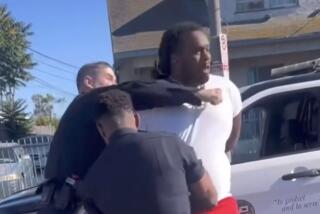The Police Reform That Must Not Die : Community-policing push affirms City Hall commitment
- Share via
One nagging fear about Richard Riordan when he was running for mayor last summer was that he was not in truth deeply committed to thorough reform of the Los Angeles Police Department. But now, at least on the evidence of his first few months in office, that would be a hard case to make. After all, he couldn’t be more visible in his support of Police Chief Willie L. Williams, who was the nearly unanimous selection to take over the department amid the ashes of the Rodney King controversy and the inept police response to the 1992 riots. And the mayor has hunted anywhere and everywhere to find funds for more police officers--absolutely vital in themselves because the city is shockingly underpoliced but also vitally necessary for the proposed reforms, which emphasize the labor-intensive philosophy of community policing.
A BIG PLAN: And now, reinforcing the increasing optimism about police reform, the city has unveiled its most ambitious community-policing plan to date. It involves deploying 30 experienced officers in a large, crime-plagued area of the city. These lead officers are to join with community leaders and citizen volunteers in an alliance against street crime.
This is a major and very public redeployment of officers; failure would be highly visible. And the effort takes no shrinking-violet approach: The department did not choose some country-club precinct for the rollout but instead an often crime-troubled stretch that extends from the downtown section of the Santa Monica Freeway to the southern edge of the city--the territory of the LAPD’s South Bureau. The area has a population of 750,000.
The program was announced with fanfare at a high departmental level--by Deputy Los Angeles Police Chief Mark A. Kroeker, who has said he sees nurturing his officers’ personal involvement with the community they serve as a top priority. Kroeker, who now heads the South Bureau, enjoyed success with community outreach programs when he was San Fernando Valley commander. He was more inclined to such community-oriented policing programs than some of his bosses downtown, who tended to favor glitzy specialized units and tactical forces under headquarters command.
A BIG SWITCH: That approach had its sincere defenders, of course: Especially when a police department has too few officers for the territory it must police, the temptation is to use high technology and centralized units to maximize results. But, interestingly, the headquarters-unit style was not favored by LAPD Chief Ed Davis, who retired from the department in 1978. In fact, Davis was a nationally recognized proponent of community policing, an approach all but abandoned by his successor.
Community policing rose from the dead in the famous Christopher Commission Report of 1991, which proposed this street-based approach because of a deep worry that the LAPD had not only grown alienated from much of the community but had actually antagonized important portions of it.
Thus the new approach developed not only in response to growing citizen fears about crime but also in response to growing concerns that the department had become its own worst enemy, closing itself off from the community and, in effect, pulling up the drawbridge.
It is therefore deeply reassuring to see that City Hall appears to be embracing, not abandoning, the hard work and substantial wisdom of the Christopher Commission.
More to Read
Sign up for Essential California
The most important California stories and recommendations in your inbox every morning.
You may occasionally receive promotional content from the Los Angeles Times.













